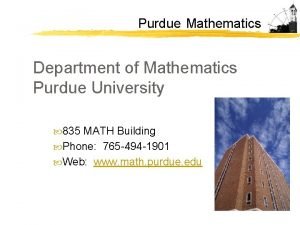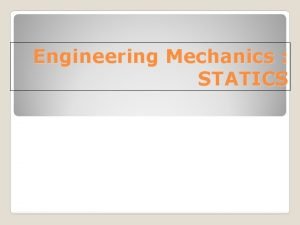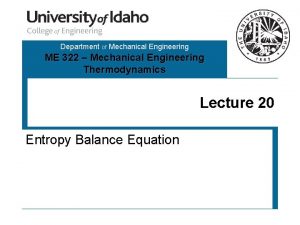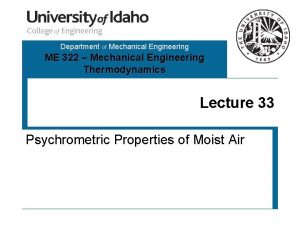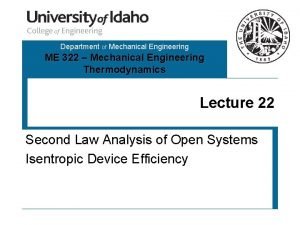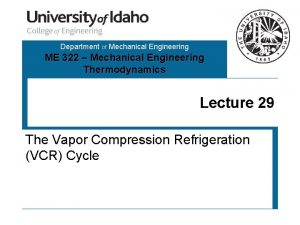Faculty of Engineering Mechanical Engineering Department MATH 2140



































![Example (Exercise) Calculate f[x 1, x 0] and f[x 4, x 3]. i xi Example (Exercise) Calculate f[x 1, x 0] and f[x 4, x 3]. i xi](https://slidetodoc.com/presentation_image_h2/7080da2c4129f3cb54fac5bd2e3b28b6/image-36.jpg)













- Slides: 49

Faculty of Engineering Mechanical Engineering Department MATH 2140 Numerical Methods Instructor: Dr. Mohamed El-Shazly Associate Prof. of Mechanical Design and Tribology melshazly@ksu. edu. sa Office: F 072 1

Curve-Fitting Polynomial Interpolation 2

Outline n Introduction n Curve Fitting? n Interpolation? 3

Introduction n Curve fitting? – To fit a smooth and continuous function (curve) to the available discrete data. Figure 5. 1 Collocation n -Fitting polynomials n A familiar example: In the Free-fall lab in General Physics I, you are asked to fit a function (quadratic) to the data of position v. s. time. Two approaches: (1) (2) Collocation: The approximating function passes through all the data points. Usually used when the data are known to be accurate. Least-square regression: The approximating curve represents the general trend of the data. Usually used when the data appear to have significant error. 4

Table_6 -1 Copyright © 2014 John Wiley & Sons, Inc. All rights reserved.

Fig_6 -1 Copyright © 2014 John Wiley & Sons, Inc. All rights reserved.

Interpolation? n Interpolation is a procedure for estimating a value between known values of data points. It is done by first determining a polynomial that gives the exact value at the data points, and then using the polynomial for calculating values between the points. 7

Fig_6 -2 Figure 6 -2: Interpolation 8

6. 2 CURVE FITTING WITH A LINEAR EQUATION n Curve fitting using a linear equation (first degree polynomial) is the process by which an equation of the form: 9

10

Linear Least-Squares Regression n n Linear least-squares regression is a procedure in which the coefficients a 1 and a 0 of a linear function y = a 1 x + a 0 are determined such that the function has the best fit to a given set of data points. The best fit is defined as the smallest possible total error that is calculated by adding the squares of the residuals according to Eq. (6. 5). 11

12

13

14

15

Curve Fitting Regression Linear Regression Polynomial Regression Multiple Linear Regression Non-linear Regression Interpolation Newton's Divided-Difference Interpolation Lagrange Interpolating Polynomials Spline Interpolation 16

Interpolation • Given a sequence of n unique points, (xi, yi) • Want to construct a function f(x) that passes through all the given points so that … • We can use f(x) to estimate the value of y for any x inside the range of the known base points 17

Extrapolation • Extrapolation is the process of estimating a value of f(x) that lies outside the range of the known base points. • Extreme care should be exercised where one must extrapolate. 18

Polynomial Interpolation Objective: Given n+1 points, we want to find the polynomial of order n that passes through all the points. 19

Polynomial Interpolation • The nth-order polynomial that passes through n+1 points is unique, but it can be written in different mathematical formats: – The conventional form – The Newton Form – The Lagrange Form • Useful characteristics of polynomials – Infinitely differentiable – Can be easily integrated – Easy to evaluate 20

Characteristics of Polynomials • Polynomials of order n – Has at most n-1 turning points (local optima) – Hast at most n real roots • At most n different x's that makes pn(x) = 0 • pn(x) passes through x-axis at most n times. • Linear combination of polynomials of order ≤ n results in a polynomial of order ≤ n. – We can express a polynomial as sum of polynomials. 21

Conventional Form Polynomial • To calculate a 0, a 1, …, an • Need n+1 points, (x 0, f(x 0)), (x 1, f(x 1)), …, (xn, f(xn)) • Create n+1 equations which can be solved for the n+1 unknowns as: 22

Conventional Form Polynomial • What is the shortcoming of finding the polynomial using this method? • This system is typically ill-conditioned. – The resulting coefficients can be highly inaccurate when n is large. 23

Alternative Approaches • If our objective is to determine the intermediate values between points, we can construct and represent the polynomials in different forms. • Newton Form • Lagrange Form 24

Constructing Polynomial • Let pn(x) be an nth-order polynomial that passes through the first n+1 points. • Given 3 points i xi f(xi) 0 1 4 1 2 2 2 3 5 • We can construct p 0(x) as p 0(x) = f(x 0) = 4 i. e. , the 0 th-order polynomial that passes through the 1 st point. 25

Constructing Polynomial – p 1(x) • We can construct p 1(x) as p 1(x) = p 0(x) + b 1(x – 1) for some constant b 1 i xi f(xi) 0 1 4 1 2 2 2 3 5 • At x = x 0 = 1, b 1(x – 1) is 0. Thus p 1(1) = p 0(1). – This shows that p 1(x) also passes through the 1 st point. • We only need to find b 1 such that p 1(x 1) = f(x 1) = 2. • At x = x 1 = 2, p 1(2) = p 0(2) + b 1(2 – 1) => b 1 = (2 – 4) / (2 – 1) = -2 • Thus p 1(x) = 4 + (-2)(x – 1) 26

Constructing Polynomial – p 2(x) • We can construct p 2(x) as p 2(x) = p 1(x) + b 2(x – 1)(x – 2) for some constant b 2 i xi f(xi) 0 1 4 1 2 2 2 3 5 • At x = x 0 = 1 and x = x 1 = 2, p 2(x) = p 1(x). – So p 2(x) also passes through the first two points. • We only need to find b 2 such that p 2(x 2) = f(x 2) = 5. • At x = x 2 = 3, p 1(3) = 4 + (-2)(3 – 1) = 0 p 2(3) = p 1(3) + b 2(3 – 1)(3 – 2) => b 2 = (5 – 0) / 2 = 2. 5 • Thus p 2(x) = 4 + (-2)(x – 1) + 2. 5(x – 1)(x – 2) 27

Constructing Polynomial – pn(x) • In general, given n+1 points (x 0, f(x 0)), (x 1, f(x 1)), …, (xn, f(xn)) • If we know pn-1(x) that interpolates the first n points, we can construct pn(x) as pn(x) = pn-1(x) + bn(x – x 0)(x – x 1)…(x – xn-1) where bn can be calculated as 28

Constructing Polynomial – pn(x) We can also expand pn(x) = pn-1(x) + bn(x – x 0)(x – x 1)…(x – xn-1) recursively and rewrite pn(x) as pn(x) = b 0 + b 1(x – x 0) + b 2(x – x 0)(x – x 1) + … + bn(x – x 0)(x – x 1)…(x – xn-1) where bi can be calculated incrementally as 29

Calculating the Coefficients b 0, b 1, b 2, …, bn • A more efficient way to calculate b 0, b 1, b 2, …, bn is by calculating them as finite divided difference b 1: Finite divided difference for f of order 1 b 2: Finite divided difference for f of order 2 [ f'(x) ] [ f"(x)] 30

Finite Divided Differences Recursive Property of Divided Differences • The divided difference obey the formula Invariance Theorem • The divided difference f[xk, …, x 1, x 0] is invariant under all permutations of the arguments x 0, x 1, …, xk. 31

Interpolating Polynomials in Newton Form 32

Graphical depiction of the recursive nature of finite divided differences. 33

Example Construct a 4 th order polynomial in Newton form that passes through the following points: i xi f(xi) 0 0 -5 1 1 -3 2 3 -1 2 -15 39 4 -2 -9 We can construct the polynomial as 34

Example To calculate b 0, b 1, b 2, b 3, we can construct a divided difference table as i xi f[ ] 0 1 2 0 -5 1 -3 -1 -15 3 4 2 39 -2 -9 f[ , ] f[ , , ] i xi f(xi) f[ , , , ] 0 0 -5 1 1 -3 f[ , , ] 2 3 -1 2 -15 39 4 -2 -9 35
![Example Exercise Calculate fx 1 x 0 and fx 4 x 3 i xi Example (Exercise) Calculate f[x 1, x 0] and f[x 4, x 3]. i xi](https://slidetodoc.com/presentation_image_h2/7080da2c4129f3cb54fac5bd2e3b28b6/image-36.jpg)
Example (Exercise) Calculate f[x 1, x 0] and f[x 4, x 3]. i xi f[ ] f[ , , , ] 0 0 -5 1 2 3 4 1 -1 2 -2 -3 f[x 2, x 1] f[x 3, x 2, x 1] f[x 4, x 3, x 2, x 1] -15 f[x 3, x 2] f[x 4, x 3, x 2] 39 f[x 4, x 3] -9 f[ , , ] f[x 1, x 0] f[x 2, x 1, x 0] f[x 3, x 2, x 1, x 0] f[x 4, x 3, x 2, x 1, x 0] 36

Example To calculate b 0, b 1, b 2, b 3, we can construct a divided difference table as i xi f[ ] f[ , ] 0 1 2 0 -5 1 -3 -1 -15 2 6 18 3 4 2 39 -2 -9 12 f[ , , ] f[ , , , , ] 37

Example To calculate b 0, b 1, b 2, b 3, we can construct a divided difference table as i xi 0 1 2 3 4 f[ ] f[ , , ] 0 -5 1 -3 -1 -15 2 6 18 -4 12 6 2 39 -2 -9 12 f[ , , , ] f[ , , ] 38

Example To calculate b 0, b 1, b 2, b 3, we can construct a divided difference table as i xi 0 1 2 3 4 f[ ] f[ , , , ] 0 -5 1 -3 -1 -15 2 6 18 -4 12 6 8 2 2 39 -2 -9 12 f[ , , ] 39

Example To calculate b 0, b 1, b 2, b 3, we can construct a divided difference table as i xi 0 1 2 3 4 f[ ] f[ , , , , ] 0 -5 1 -3 -1 -15 2 6 18 -4 12 6 8 2 39 -2 -9 12 40

Example To calculate b 0, b 1, b 2, b 3, we can construct a divided difference table as i xi f[ ] f[ , , , , ] 0 1 2 0 -5 1 -3 b 0 -1 -15 2 6 b 1 18 -4 12 b 2 6 8 2 b 3 3 3 4 2 39 -2 -9 12 b 4 Thus we can write the polynomial as 41

Polynomial in Nested Newton Form • Polynomials in Newton form can be reformulated in nested form for efficient evaluation. • For example, can be reformulated in nested form as 42

Lagrange Interpolating Polynomials Construct a polynomial in the form 43

Lagrange Interpolating Polynomials • For example, 44

Example Construct a 4 th order polynomial in Lagrange form that passes through the following points: i xi f(xi) 0 0 -5 1 1 -3 2 3 -1 2 -15 39 4 -2 -9 We can construct the polynomial as where Li(x) can be constructed separately as … (see next page) 45

Example i xi f(xi) 0 0 -5 1 1 -3 2 3 -1 2 -15 39 4 -2 -9 46

Lagrange Form vs. Newton Form • Lagrange – Use to derive the Newton-Cotes formulas for use in numerical integration • Newton – Allows construction of higher order polynomial incrementally – Polynomial in nested Newton form is more efficient to evaluate – Allow error estimation when the polynomial is used to approximate a function 47

Summary • Polynomial interpolation for approximate complicated functions. (Data are exact) • How to construct Newton and Lagrange Polynomial. – How to calculate divided difference of order n when given n+1 data points. 48

Interpolation Error ** • If pn(x) interpolates f(x) at x 0, …, xn, then the interpolation is • When using pn(x) to approximate f(x) in an interval, one should select n+1 Chebyshev nodes/points (as oppose to equally spaced points) from the interval in order to minimize the interpolation error. 49
 Prepets
Prepets 2140 assignment
2140 assignment Faculty of mechanical engineering thammasat university
Faculty of mechanical engineering thammasat university Nit calicut chemistry department faculty
Nit calicut chemistry department faculty Actual mechanical advantage vs ideal mechanical advantage
Actual mechanical advantage vs ideal mechanical advantage Lee kong chian faculty of engineering and science
Lee kong chian faculty of engineering and science Czech technical university in prague civil engineering
Czech technical university in prague civil engineering Faculty of engineering shoubra
Faculty of engineering shoubra Faculty of engineering university of porto
Faculty of engineering university of porto Usf electrical engineering faculty
Usf electrical engineering faculty Civil engineering faculty
Civil engineering faculty St anns college chirala
St anns college chirala Etfbl
Etfbl Hijjawi faculty for engineering technology
Hijjawi faculty for engineering technology Faculty of engineering lebanese university
Faculty of engineering lebanese university Clemson university electrical engineering
Clemson university electrical engineering Lee kong chian faculty of engineering and science
Lee kong chian faculty of engineering and science Andy fisher mun
Andy fisher mun Studis fe
Studis fe Uta maa
Uta maa Math department meeting agenda
Math department meeting agenda Math department wvu
Math department wvu Math 1275 city tech
Math 1275 city tech Isabel darcy
Isabel darcy Usm math department
Usm math department Purdue university actuarial science
Purdue university actuarial science Sol score range
Sol score range Oklahoma state department of education math standards
Oklahoma state department of education math standards Nku math department
Nku math department Haverford biology
Haverford biology Ksu math department
Ksu math department Waterloo applied math
Waterloo applied math Math game math hit the button
Math game math hit the button Ytu erasmus
Ytu erasmus Mechanical engineering rit
Mechanical engineering rit Nps mechanical engineering
Nps mechanical engineering Mechanical engineering usf flowchart
Mechanical engineering usf flowchart Specialcourseinfo
Specialcourseinfo King saud university mechanical engineering
King saud university mechanical engineering Importance of machine design in mechanical engineering
Importance of machine design in mechanical engineering Centroid in engineering mechanics
Centroid in engineering mechanics Mechanical engineering presentation
Mechanical engineering presentation Standard drawing scale
Standard drawing scale Adelien heutink
Adelien heutink Welding process
Welding process Mechanical engineering mecop
Mechanical engineering mecop Mechanical engineering design book
Mechanical engineering design book San jose state mechanical engineering
San jose state mechanical engineering Mcpsmd pdo
Mcpsmd pdo Basic mechanical engineering syllabus
Basic mechanical engineering syllabus

























